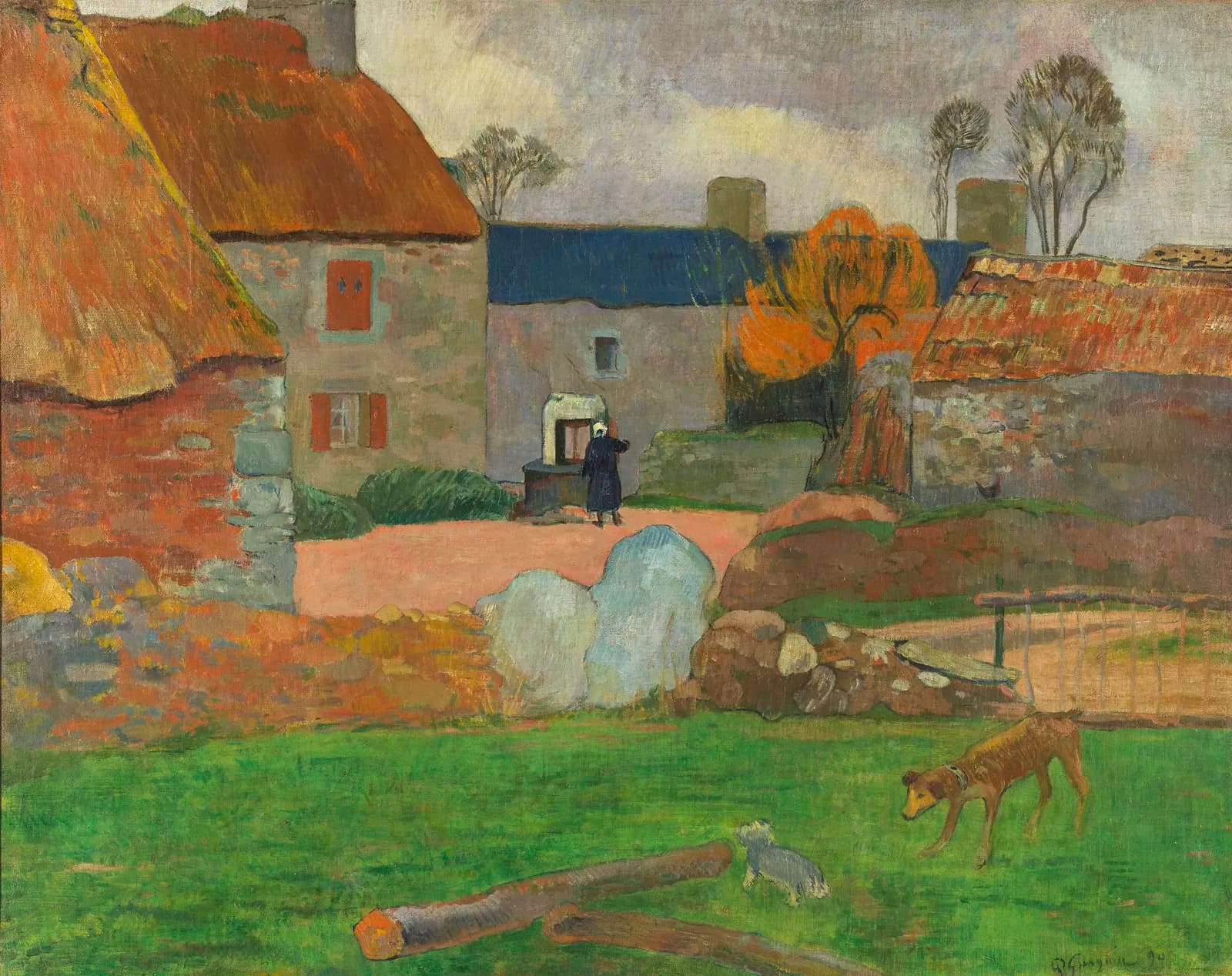The blue roof

Paul Gauguin, Le toit bleu or Ferme au Pouldu (The blue roof or Farm at Le Pouldu), 1890, National Gallery of Australia, Kamberri/Canberra, purchased with the assistance of the National Gallery of Australia Foundation 2024
To celebrate the Gallery's acquisition of The blue roof or Farm at Le Pouldu, 1890 by the influential French artist PAUL GAUGUIN, curator LUCINA WARD reflects on Gauguin's time spent on the Breton coast.
‘Here in Brittany the peasants have a medieval air about them and don’t appear to think for a moment that Paris exists and that we’re in the year 1889 … everything is rough like the Breton language, very closed-in (for evermore, it seems).’1
The blue roof or Farm at Le Pouldu is among a small number of works painted by Gauguin at Le Pouldu on the Breton coast. From July 1886 until his departure for Tahiti in April 1891, he travelled regularly between Paris, towns in Brittany and to the South of France, searching for a way to consolidate his style, as well places to live cheaply. He absorbed the region’s peasant traditions, music and especially woodcarving, and described scrutinising ‘the horizons, seeking that harmony of human life with animal and vegetable life through compositions in which I allowed the great voice of the earth to play an important part.’2 This painting is an exceptionally picturesque scene of a country farmyard: at the centre of the composition, a woman is shown drawing water from a well, framed and almost subsumed by the rustic farm buildings.
By 1885 Gauguin was painting full-time and, from his first campaign in Brittany, reducing traditional modelling to a strict minimum: the combination of colour and form in his Pont-Aven and Le Pouldu works is striking. Having abandoned Pont-Aven as too spoilt by crowds, he set off for the remote hamlet of Le Pouldu, some twenty kilometres south-west, with its dramatic rocky peninsula, windswept dunes, sandy beaches and scattered farms. The images of peasant life, the landscape and harvest scenes he painted there late in 1889 and during 1890 are some of the most radically simplified of his career. At Buvette de la Plage, the inn owned by local woman Marie Henry, he was joined by Paul Sérusier (1864–1927) and Jacob Mayer de Haan (1852–1895), and the three artists painted the same scenes.3 They built on and extended their exploration of cloisonnist techniques, outlining their forms using thin lines of black or dark blue paint.

Paul Gauguin, Edward Ancourt & Cie, Bretonnes à la barrière [Breton women by a fence], 1889, National Gallery of Australia, Kamberri/Canberra, felix Man Collection, Special Government Grant 1972

Paul Sérusier, La Savoyarde [Woman from Savoy], 1890, National Gallery of Australia, Kamberri/Canberra, purchased 2016

Landscape of Brittany, 1888, also known as Petit berger breton, oil on canvas, 89.3 × 116.6 cm, The National Museum of Western Art, Tokyo. Matsukata Collection, P.1959-0105
In The blue roof or Farm at Le Pouldu Gauguin varies his brushstrokes to capture a sense of the rough surfaces of the stone buildings, thatched roofs and the surrounding vegetation. The composition centres on the figure of the woman, dressed in dark blue with a white cap, and the well. Two dogs provide further interest. The work has elements of a traditional landscape—the bands of sky, the massed buildings of the mid-section and grassed area of the foreground—but the flattening of the scene and the rich patterns develops from various elements give the scene a tapestry-like effect. The previous year Gauguin had experimented with a technique he learnt from a restorer which, using paste, newspaper and horn irons, produced a matt surface.4 The buildings and female figure reappear in two other paintings of the same year, similar dimensions and palette, Haystacks in Brittany and Landscape at Le Pouldu.5 Richard Brettell suggests the canvasses may form a triptych.6 While this may be an unusual format for Gauguin at the time, when the paintings are considered together, the frieze-like quality seems to prefigure some of his large-scale Polynesian works.
The blue roof or Farm at Le Pouldu is on display in Gauguin’s World: Tōna Iho, Tōna Ao until 7 October 2024. The first painting by Paul Gauguin in an Australian public collection, The blue roof or Farm at Le Pouldu has been purchased with the assistance of the National Gallery Foundation. A welcome addition to the national collection—where it joins several prints by Gauguin and Paul Sérusier’s painting from the same year Woman from Savoy—The blue roof or Farm at Le Pouldu will be on show in the permanent collection galleries in late 2024.

